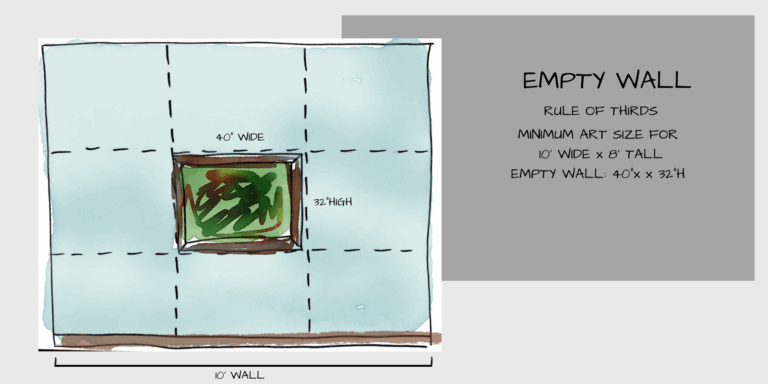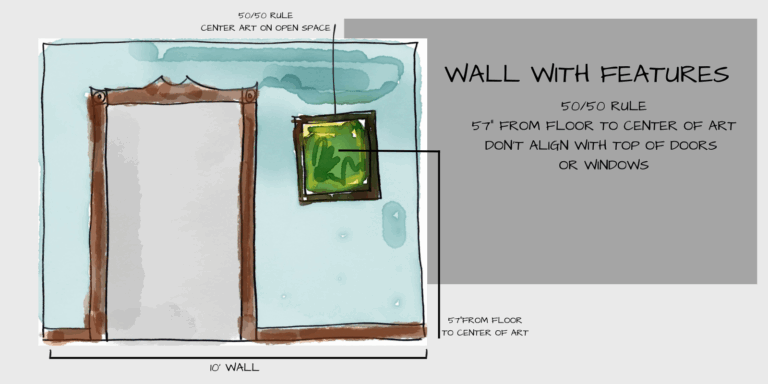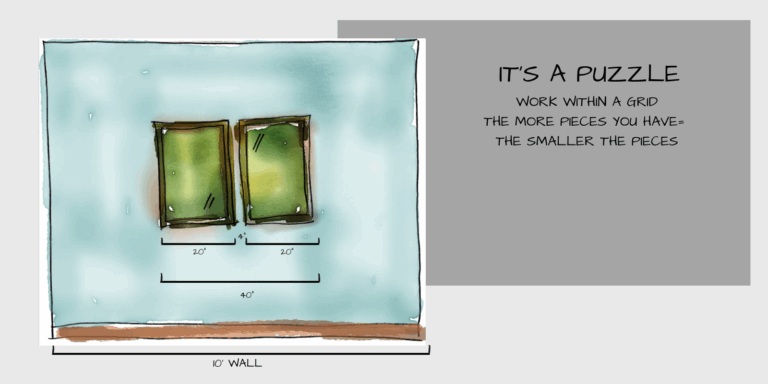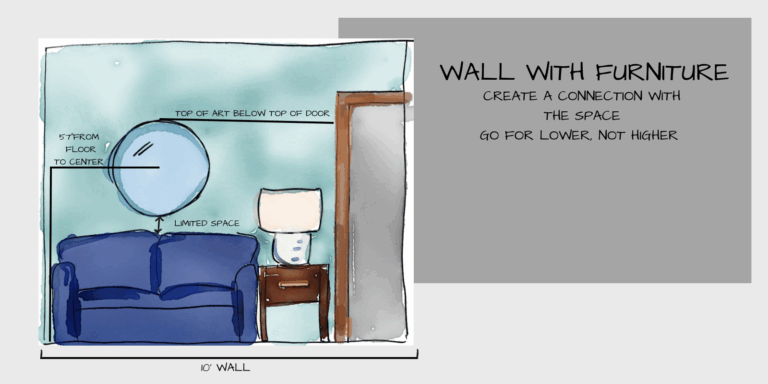Book a Complimentary Discovery Call
Speak with our Principal Interior Designer, Dana Feagles.
Tell us about your project, your needs, your hurdles, and your aspirations.
Learn how we can help.
As an interior designer, one of the first things I always recommend to a client who feels their room is “unfinished” is to get some artwork on those blank walls. Wall decor makes a big difference, but it’s often overlooked. That’s why I’ve put together “The Ultimate Guide to Wall Art Hanging Rules”, which is simple enough for anyone to follow!
I once shared my thoughts in Homes & Gardens Magazine in the article “Expert Designer Tips: Should every wall have something on it?” You can read ideas from a whole group of designers there, but keep reading for more detailed tips from me.
Too much reading? I get it. You can always book a Discovery Call and I’ll help you out.
First, let’s talk about the wall itself. Is it completely empty, or does it have windows, doors, or a fireplace? Each type needs a slightly different approach.

One of the most common mistakes I see is artwork that’s too small for the wall. To avoid this, use the “rule of thirds.”
Take the width of the wall, divide it by three, and that’s your minimum artwork width. If your wall is 10 feet long, look for a picture or group of pictures that’s at least 40 inches wide, centered on the wall.
The same idea applies to height. If your ceiling is 8 feet high, look for art that’s around 32 inches tall.
If your wall has features that break up the space, I like to use the 50/50 rule. For example, if a 10-foot wall has a 3-foot-wide door in the middle, that leaves 42 inches of space on each side. Your wall decor should take up no more than half of that space, or 21 inches wide.

As for height, you have more flexibility. Try three smaller pieces stacked vertically, or go bold with one tall piece. Just make sure the center is around 57 inches from the floor, which is standard eye level.
And please don’t try to line up the tops of your frames with the tops of your doors or windows. It makes things feel off. Aim for eye level, especially for mirrors.
There’s no right number of frames. What matters is that they fit within the visual boundary you’ve created with your layout.

Think of it like a puzzle. The more pieces you want to include, the smaller each one has to be.
One big piece is great, or two medium pieces side by side. You can even do a grid of five small frames if you map it out carefully. Don’t eyeball it, this is the fun kind of math.
This one’s simple. Artwork should generally be hung at 57 inches from the floor to the center of the piece. That’s standard eye level. If you’re hanging art over a bed, sofa, or console, go lower. You want it to feel connected to the furniture, not floating above it.

Empty Walls (no windows or doors):
Walls with Architectural Features (windows, doors, etc.):
If the space is wider than 24 inches:Follow the 50/50 rule and balance the space with art or other decor like a tall lamp or vase.
Final Tip:
If you’re ready to elevate your space with artwork but feel a little unsure about where to begin, don’t stress! Navigating wall art placement can feel tricky, but with our guidance, it’ll feel like second nature. Whether you need help with choosing the right pieces or just want a fresh perspective on your space, we’re here to help you make it happen. Reach out to us at hello@revelryinteriordesign.com or book a free consultation here. Let’s transform those blank walls into something beautiful!
Subscribe to our monthly newsletter for even more expert tips, design inspiration, and a glimpse behind the scenes at Revelry Interior Design.
Cheers,
Dana Feagles, Principal Interior Designer
(Original post “The (Almost) Ultimate Guide to Wall Art Hanging Rules” posted on May 17, 2023 HERE)
Speak with our Principal Interior Designer, Dana Feagles.
Tell us about your project, your needs, your hurdles, and your aspirations.
Learn how we can help.